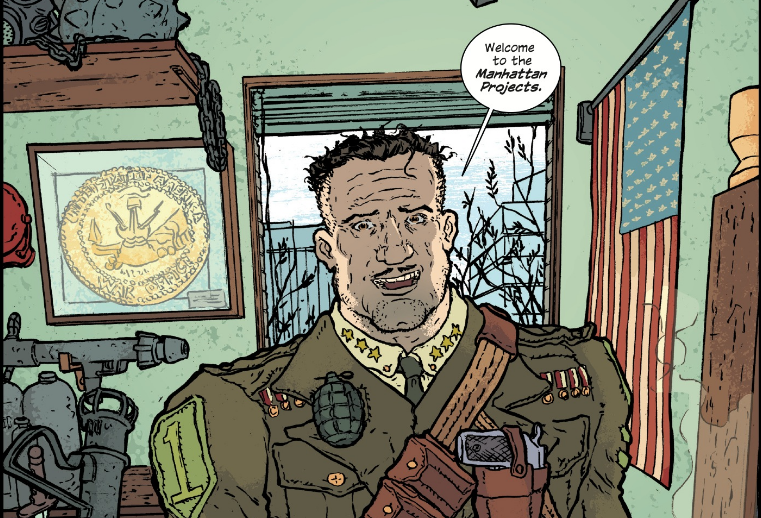Last week we explored the major themes in Jonathan Hickman’s East of West. This week we continue with another Hickman series, The Manhattan Projects, and this time the main theme is deception. Hickman does also include his usual themes of hubris, love, and family relationships (particularly the paternal), but deception is the engine that drives this story.
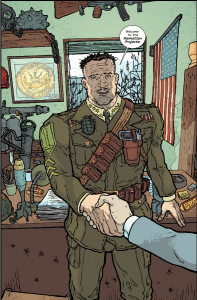
Last week I made the superficial comparison between East of West and The Manhattan Projects in that they both deal with alternate histories. The main difference at this level is that the former diverges after the Civil War while the latter diverges during World War II. But that’s where the similarities end. East of West is self-serious and the pencils and colors reflect that seriousness. The Manhattan Projects is, in a way, dark slapstick and the caricature pencils that mirror some of the Underground Comix looks of the 70s and 80s along with a light palette reflects the comedy. Nick Pitarra, on pencil and ink duties, does a wonderful job setting the tone with all the little details in his work. Last week, I compared East of West to Kill Bill. The Manhattan Projects is like Stanley Kubrick’s Dr Strangelove. In fact, the comparison is spot on (including an ex-Nazi with a mechanical arm) – if you liked the tone of Dr Strangelove you’ll enjoy The Manhattan Projects. (And in issue #20 there’s a reference to Kubrick’s 2001: A Space Odyssey) In the first scene General Leslie Grove’s office is littered with weapons everywhere. His desk even has bullet holes and he wears a grenade on his chest.
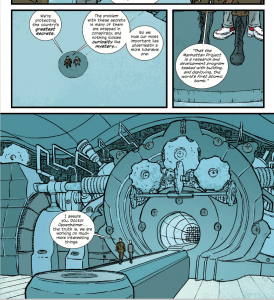
The premise of The Manhattan Projects is that the development of the atomic bomb is the least exciting thing the scientists are creating. The Manhattan Projects is a series of character studies that dovetail in and out with the developments of the scientists and the general plot. Many of the chapters spend nearly all of the time with one or two characters and the series makes heavy use of flashbacks to fill in details relevant to the current action. This allows for a second layer of deception, that of the unreliable narrator. While some issues are ostensibly narrated by one character or another, the true narrator is, of course, Jonathan Hickman. He tells the story the same way a magician does a trick – by guiding us along and revealing the past exactly when he wants, changing our perceptions of the situation at hand or the characters.
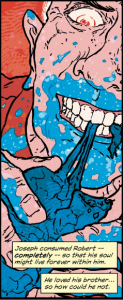
From the start deception is present as only General Leslie Groves is aware of the true nature of what the scientists are developing. Hickman takes the idea of the unstable mad scientist to the extreme as quite a few of the scientists are a bit crazy. The craziest of the scientists is the civilian head of The Manhattan Projects, Robert Oppenheimer. Hickman uses Oppenheimer to explore the concept of brotherly love in an extreme sense. Unfortunately, my Google-Fu fails me, but I remember reading a philosopher who suggested that frustration in love comes from being separate from the one we love. We want to be as close as possible and nothing could be closer than consumption. So when twins Joseph and Robert Oppenheimer are separated as Robert becomes the acclaimed scientist we know in this world, his brother kills him and eats him. Hickman also combines this with an ancient belief made real – in the past many humans believed that one could absorb a rivals skills and power by devouring them. It’s usually one of the few cases in which the cannibalism taboo doesn’t apply. In the world of The Manhattan Projects this turns out to be true and so Joseph absorbs his brother and assumes his place at The Manhattan Projects. In addition to this duplicity, he’s often withholding his true intentions and is willing to sell out the rest of the team on a moment’s notice. He is the kind of deception at The Manhattan Projects, going so far as to have a fourth special project that, as of the end of issue 20 we don’t know about.
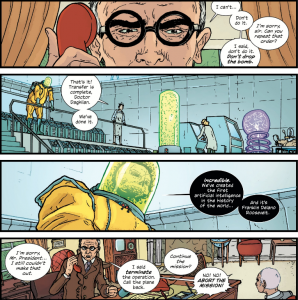
General Leslie Groves is one of the least deceptive of the team. He is usually up front with the team with the exception of when he instructed one of the scientists to destroy Harry Daghlian’s suit, wreaking genocide upon an alien race. However, when it comes to the US government he is incredibly deceptive. He drops the atomic bomb on Japan against President Truman’s order by pretending not to hear him on the phone. He allies with the Russians at Star City in direct opposition to what would be acceptable to his government and the Soviet government.
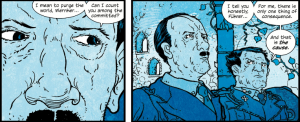
When we first meet Wernher Von Braun he is being deceptive with Adolf Hitler. By using double entendres he appears to be declaring loyalty to Nazism while actually declaring allegiance to science. He then tricks all the Nazi scientists into drinking poison so that he’s in the best possible bargaining position as the only German scientist for the Americans to pick. In flashbacks with Helmut Grottrup we see that he is also willing to take credit for Helmut’s brilliance within Germany’s rocket program.
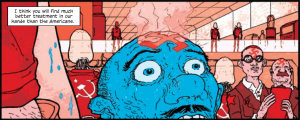
In fact, Helmut Grottrup is the only person who is not deceptive with others and he constantly suffers. He suffers under Von Braun. Then he is captured by the Soviets and branded (Inglorious Basterds style) as a Nazi. Over and over he is promised freedom and constantly denied his freedom and an end to his suffering. Even so, his desire for freedom is a bit of madness at having been a slave for so long. How free could he truly be with a swastika branded onto his forehead?
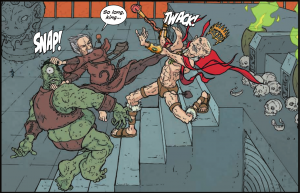
Einstein is a deceiver in the same sense as Oppenheimer, although he arrives at his impersonation by entirely different means. Albert Einstein is inspired to build a monolith. When he opens it, he finds Albreht Einstein in another world. Albreht takes his place in the main world of The Manhattan Projects, but has a bit of trouble replacing Albert because he is not as smart. He’s also an evil jerk who’s willing to sell everyone out at a moment’s notice. Because he is amoral, he has no problem working with Feynman on Oppenheimer’s project to create the perfect being, including entering the monolith over and over to collect creatures to dissect. Issue #20 details how Albert returns to the main universe and it allows Hickman to endure in another of his favorite subjects: multiple incarnations of people in different universes. (Like the many Reeds in his Fantstic Four run) Interestingly, we learn that Oppenheimer is evil in all of them.
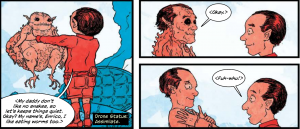
Enrico Fermi’s main deception was similar to Einstein and Oppenheimer, but with an interesting twist. He is a shape-shifting alien who was found by the real Fermi when he was a child. He made himself look like Fermi and then killed Fermi. He was on a mission to analyze and report on the status of Earth’s technology development. He commits a tragic act of deception in which we learn that he purposely causes the accident that transforms Daghlian so he can befriend him and use him.
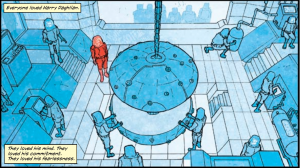
Just as this universe had consequences for Helmut for being the nice guy, Daghlian (who as of now has not committed any acts of deception and seems to be a genuinely nice guy) suffers horribly. His chapter is Hickman’s meditation on the fickle nature of those we call friends. Daghlian was so nice and helpful that before the accident everyone loved him. And that love made him want to please them even more – playing a part in his willingness to participate in the experiment that destroyed his humanity. Saga taught us that the opposite of war is not peace, it’s fucking. The Manhattan Projects teaches us that the opposite of love is not hate, it’s fear. Fear is what people feel towards Daghlian after the accident. He is shunned and put into solitary confinement. There he considered suicide and stewed in anger until Fermi built his containment suit and enabled him to once again be free.
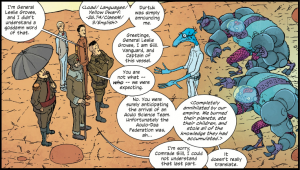
Early on we learn about some aliens that have been visiting Earth every ten years. When some new aliens arrive, they are dishonest about why they are there. It ends up being a fun little moment where we can read their untranslated threats and I almost thought it would end up being like the scene in Game of Thrones where Daenerys is being cursed out in Valerian and then it turns out she knows it. But the team does find out what they’re up to when Oppenheimer eats the alien. It leads to the aforementioned genocide.
Finally, Truman is part of the Freemasons and Illuminati and there is inherent deception in the fact that they are secretly running the world.
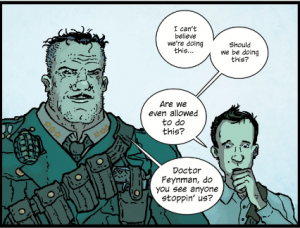
During his run on Fantastic Four Hickman explored one of the oldest plots: hubris. Reed Richards gets caught up in solving all of the multiverse’s problems during the Solve Everything storyline. There are hints of hubris as fanaticism in East of West, but it is brought to the fore in The Manhattan Projects. Best exemplified when Feynman asks if it’s OK for the team to be loading FDR’s consciousness into an AI. The response: “Do you see anyone stopping us?” Hubris and deception works for the scientists for the first half of the series thus far. But it is their undoing in the second half. When besieged on all sides, being unable to trust each other keeps them from being able to triumph. In the end it is the almost literally deus ex machina of Albert Einstein reappearing that frees the team and saves them to do science another day. (And find Laika, the space dog. Who is also deceptive by omission in that you don’t know at first that he can speak)
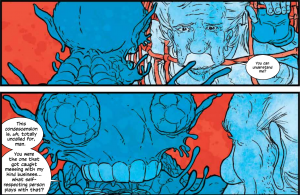
Some stray observations: I love Hickman’s oddball sense of humor with the hippie blue alien/monster. His dialogue was one of the highpoints of this series for me and his issues were my favorite issues. Also, generally speaking, blue stands for good and red for evil (in the flashbacks). In the Groves flashback the Bible is red and the Bible assures him he is righteous, leading him to drop the atomic bomb. In Einstein’s flashback, the notebook on which he writes his notes to build the monolith is red. It leads to bad times for him and genocide for the aliens. Hickman, we’ve mentioned many times on this site, places a lot of importance on father figures. Two key flashbacks – Groves/father and Feynman/father. Interestingly, Groves father is blue, but Feynman’s father is red.
As I was reading through these 20 issues I was wondering just how Hickman was going to keep The Manhattan Projects going as an ongoing series. I would say, especially given the way issue #20 ends, that it would certainly have been a natural stopping point and a very well told story if it ended there. There would have been some loose ends like General Groves and Laika, but it certainly would have told a compelling story. As it is, it appears we’re entering a new era for The Manhattan Projects and perhaps one where deception is not as strong a motif. Oppenheimer and Fermi are both dead. The team is now under Albert Einstein’s leadership. Sure, the treacherous Albreht is still around, but perhaps he’s learned his lesson? And General Groves is now working for the US government, or is that a deception? Either way, I’m looking forward to seeing where Hickman goes next.
The Manhattan Projects by Jonathan Hickman with art by Nick Pitarra and Jordie Bellaire (colors). Trades are available on Amazon (The Manhattan Projects, Vol. 1: Science Bad, The Manhattan Projects, Vol. 2
, The Manhattan Projects Volume 3 TP
, The Manhattan Projects Volume 4: The Four Disciplines TP
) and Comixology. You can buy individual issues DRM-free at Image Comics.
